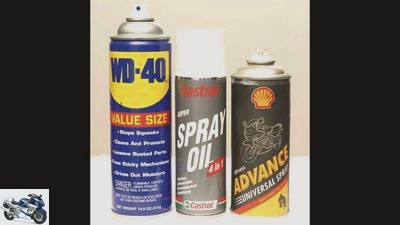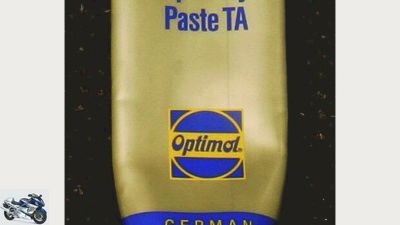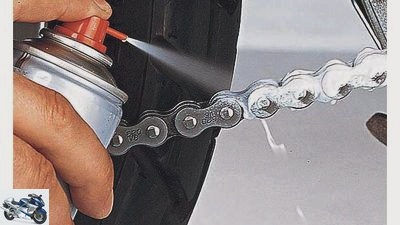Table of contents
- Guide: Basic set of care products and lubricants Chemistry in the workshop
- Guide: workshop part 2
- More about technology

Schermer
counselor
workshop
Guide: Basic set of care products and lubricants
Guide: Basic set of care products and lubricants
Chemistry in the workshop
Washing, oiling, lubricating, greasing, sealing: Anyone who wants to carry out minor or major maintenance work on their motorcycle themselves needs a certain basic set of appropriate workshop aids. We explain the most important.
Franz Josef Schermer
05/27/2010
Oil spray, polish: After each wash, give the joints of the footrests, hand and foot brake levers and the clutch lever a small shot of all-purpose oil spray. DO NOT spray anything on tires and / or brake discs! When the motorcycle is driven through rain, all-purpose oil spray prevents moisture from creeping into any cracks. Use a good all-purpose oil spray from a brand manufacturer. After driving in the rain at home, give each lubrication point a shot of oil; the oil that is sprayed on visibly displaces water. Easy running and joints without corrosion residue will thank you.
Important: Never lubricate the ignition / steering lock, the lock in the tank lid or the seat lock with oil spray or even chain spray, but use special graphite-based lock spray to lubricate the locks.
polish: Brand dealers have special polishes that match the basic colors of the machine. When you use these, you are on the safe side. This also applies to cockpit spray, tar remover and paint and chrome parts cleaners. Very good polishing and care products for various purposes are offered by the “Rot Weiss” brand.
Chrome plaster: If you don’t know “Autosol”, you’ve never cleaned your motorcycle really well: The white stuff in the black tube has been around for ages and it’s still sensationally good. Similar proven and legendary: Nevr-Dull, the ingenious polishing floss.
Clean parts: With WD-40 everything is nice and clean, the American spray removes even hard dirt. But that will be expensive! Professional workshops have so-called “parts cleaning devices”, where a biodegradable cleaning fluid is pumped from a large barrel through a brush with which the part to be cleaned is processed; the used broth runs back into the barrel through a grid. Of course, this is only possible when washing dismantled parts.

Schermer
With the right tools, everything runs like clockwork.
Parts attached to the vehicle, such as B. the (now generally open) rear-wheel drive chain can be cleaned with diesel fuel or heating oil (quite a mess, but very cheap) or with a chain cleaner made from spray cans. Petrol should not be used to clean such parts, because it is toxic, attacks the skin and is expensive.
Brake cleaner: Brake cleaner is mostly available in aerosol cans and is quite aggressive. Use only outdoors or in a well-ventilated workshop. Do not smoke! Do not spray on the skin, in the eyes or in the respiratory tract! Avoid inhalation!
- Only use brake cleaner or acetone to clean brake components, DO NOT use gasoline, diesel oil, engine oil or oil spray!
- Use brake cleaner sparingly and in a targeted manner, point the spray head directly at the area to be cleaned and do not press it for longer than two seconds.
- After spraying the brake cleaner, clean parts immediately with a soft, lint-free cloth.
Lubrication points: Lubricating the moving parts of the vehicle operation is primarily used to keep dirt and water away from their joints and to prevent rust, so that smooth movement and a long service life are guaranteed. The mutually movable aluminum parts such. B. the joints of the clutch and brake levers do not corrode when they are clean. However, if these joint and contact points are not maintained regularly, there will also be corrosion over time, which will result in stiffness. Because when the motorcycle is parked outdoors, environmental dirt from the air is deposited on it and creeps into the joints. During the small inspections or at least twice a year (spring and autumn) the following should be lubricated:
- Stand hinges and bearing points of the stand springs with heavy bearing grease. Spraying with oil spray after washing prevents rust.
- Throttle twist grip: If it is stiff, it must be opened for lubrication with light molybdenum grease.
oil: Oil is the most important workshop tool. A stylish oil can must be on every workbench, because a drop of oil belongs on nuts and bolts before assembly. Of course you can also use all-purpose oil spray or WD 40, but the frequent use of spray becomes really expensive over time.
Good quality oil belongs in the oil can. So another warning to the hardware store: Don’t buy a “great oil can with 150 ml of all-purpose oil for only 1.95 euros” there, that’s far too expensive for the cheapest grease. It is better z. For example, you can collect the last remnants of engine oil cans or bottles by placing the oil bottle upside down in a beaker so that it can drip off and thus collect “drip oil”. This is by no means exaggerated stinginess, but why throw away the apparently empty oil can when there are still a few cubic centimeters of good (and expensive!) Engine oil in it?
fat: In addition to oil, lubricating grease is another important basic aid in the motorcycle workshop. Motorcycle grease should be as (salt) water resistant as possible. We need two types of grease for the motorcycle:
- “Light roller bearing grease” for rapidly rotating components such as wheel bearings or wheel bearing Simmerrings (important when installing wheels). As the term “light” suggests, the fat is “light” and therefore particularly pliable. If you rub it between your fingers, it becomes extremely slippery. You can practically feel the lubricating film while rubbing, and afterwards the fat can hardly be washed off the skin.
- “Heavy roller bearing grease” for slowly rotating components such as steering head and swing arm bearings, joint bolts of footrests, shift and brake levers. When you rub your fingers, you can feel that the heavy grease is stiffer than light roller bearing grease. That is why it is not suitable for rapidly rotating components such as wheel bearings, but it can withstand much higher pressures.
Workshop aids: Many workshop aids are made by the chemical giant Henkel, such as B. liquid screw locking agents (“Loctite”) and sealants. Loctite product descriptions can be found on the Internet at www.loctite.de and information about their use can be found. Good motorcycle dealers usually offer all the workshop aids you need.
You should have the greases already discussed at the beginning of the text as well as contact spray, Molykote grease (silicone grease), sealant 3-Bond (surface sealant), Loctite 577 (thread sealant), Loctite 243 (screw lock “medium strength”), Loctite 2701 (screw lock “high strength”) and brake cleaner.
Guide: workshop part 2

fact
The chain is not damaged if it is properly lubricated.
Greasing, oiling, gluing:
- Fats: If bare components are screwed together, lubricate the contact surfaces of both parts with a little grease beforehand. Then they won’t rust, because grease between two mating surfaces prevents moisture from penetrating.
- Oil: When screws and nuts are processed, always put a drop of oil on / into their threads and contact surfaces. Before oiling or reinstalling removed screws, first clean them with clean oil and a lint-free cloth.
- Adhere: Loctite “medium strength” holds every screw connection together reliably. In the case of extremely stressed screw connections, such as B. the fastening screws of the brake discs, Loctite “high strength” is prescribed. Put a drop on screws and into the thread of nuts. Important: Even when using screw adhesive, each screw connection must be tightened with the prescribed tightening torque.
Surface sealant: Surface sealants are required if z. B. a housing cover is built on the engine and no paper seal is provided. Or if you have to screw on the road and the paper seal tears during dismantling. It is essential to buy a silicone sealant that is compatible with oil and grease and has a temperature resistance of -40 to 250 degrees, NOT for water pipes, window or shower cubicle installation (is usually offered in hardware stores). Silicone sealant should only be used if component is installed on component without a new, interposed paper seal. So:
- Do not use additional sealant on a new paper seal.
- If a used, cured paper gasket must be used, lightly and evenly lubricate both sides of the gasket with silicone sealant
- It is very important that the silicone sealant that is smeared on is “flashed off” for ten minutes – so do not touch it, do not build on, the sealant has to flash off until it is almost solid.
Silicone paste: Rubber parts can be cared for wonderfully with silicone paste (or silicone spray), they stay supple and do not break because they do not dry out. This applies above all to the shock absorbers in the rear wheel: When removing or installing the wheel for the purpose of changing tires, the shock absorbers (these are so-called “rubber molded parts”) should be removed, cleaned and smeared with silicone paste, this keeps them elastic and prevents embrittlement. Even when overhauling brake calipers and brake pumps, a little silicone paste on the brake sleeves is a must. The toothed belt can be cared for very well with silicone spray: First, use clear water and a hard nylon toothbrush to remove all dirt from the teeth of the belt and pulley, then lightly spray the inside of the belt with silicone spray. That works wonders, the belt runs even quieter and lasts longer.
Contact spray: Rotten electrical contacts create electricity barriers. The indicator doesn’t work? When switching from high to low beam does the light flicker? The brake light is crazy? Take a look at the plugs: Electro-yellow ensures that nothing works anymore. Pull the connector apart, spray the contacts with contact spray, clean with a hard (dry) toothbrush or a fine brass brush, remove the contact tongues with fine sandpaper and put the connector back together with a dash of contact spray – then it’s mostly done again.
Battery grease: When screwing on the battery terminals, clean the poles with a brass brush or fine emery paper. A little bit of pole grease on terminals, connections and screws / nuts ensures a corrosion-free fit and thus the best possible current flow.
Copper paste : You can also say “hot fat” or “ceramic paste”. This fat should be used when assembling the exhaust, because it can withstand temperatures of over 1000 degrees and does not stick. Greased very thinly on the edges and back of the brake pads (only very thin, really!) It prevents corrosion between the brake caliper and the brake pad carrier plate. It can also be used for the assembly of spark plugs – but please only put a very small drop on the thread of the spark plug, that’s enough.
Ultrasonic cleaning device: If all else fails, if the carburetor is clogged with solid residues, then it has to be dismantled and “boiled” in an ultrasonic cleaning device. Housing parts that are dirty through and through, because they have been scarred, become sparkling clean again in an ultrasonic device. The disadvantage is that such a part is expensive – there is nothing clever for less than 2000 euros.
More about technology
PS knowledge: technology
- Motorcycle technology clearly explained on 97 pages (PDF)
- From starter to spark plug
- Simple teaching of physical principles
- Tips and tricks for practitioners
To the PDF for € 9.99
#image.jpg
Related articles
-
jkuenstle.de 23 pictures Bilski 1/23 Beauty caress: When everything else is in good condition and you really don’t have to paw around with dirty paws on…
-
Guide to changing the brake pads on the motorcycle
Ralf Schneider counselor workshop Guide to changing the brake pads on the motorcycle Change the brake pads on the motorcycle Tips from professionals…
-
Oil care tips for the motorcycle
Schoch 30th pictures Schoch 1/30 With olive oil from mom’s kitchen, the shine of plastic parts on the motorcycle can be permanently restored. Schoch 2/30…
-
Buying Guide: Parts and Products
Long accesories Buying Guide: Parts and Products Buy a guide Parts and Products Content of PS put the latest accessories to the test. Sebastian Lang…
-
Sparkling clean: Chrome care products in the test
mps photo studio accesories Sparkling clean: Chrome care products in the test Motorcycle: cleaning and care Chrome care products for motorcycles Swabian…
-
This is how it works: motorcycle care
accesories This is how it works: motorcycle care This is how it works: motorcycle care With these tips, your motorcycle will sparkle again as if it were…
-
Buy the right way: basic tools
Rutz counselor workshop Buy the right way: basic tools Buy right Basic tools Great offer: 100 pieces for 29.95 euros. You can’t go wrong with that, can…
-
Guide: Stand damage and what it costs
archive counselor Used purchase Guide: Stand damage and what it costs Advisor knowledge Stand damage and what it costs Follow-up costs due to damage to…
-
Guide: Braking correctly, part 1 – without ABS
jkuenstle.de 9 pictures 1/9 Braking properly without ABS: Your colleague shows you how: knees on the tank, upper body upright, view far ahead. The arms…
-
Photo: Rossen Gargolov 9 pictures Artist 1/9 While the machine is being cleaned, it can be checked for defects at the same time. Herder 2/9 Let the chain…